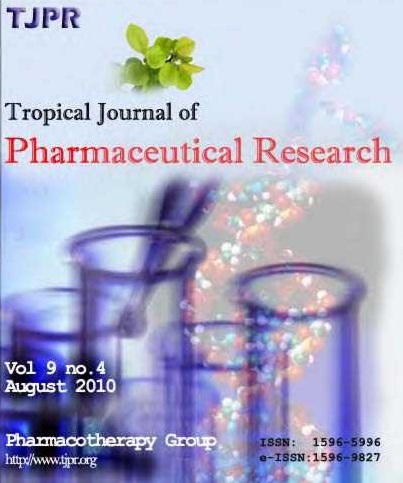Ruscogenin regulates endogenous antioxidation in dopamine neurons by activating Keap1/Nrf2/HO-1 pathway
IF 0.6
4区 医学
Q4 PHARMACOLOGY & PHARMACY
引用次数: 0
Abstract
Purpose: To investigate the effect of ruscogenin (RUS) on cell viability, lipid peroxidation and mitochondrial dysfunction in a Parkinson’s disease (PD) model.Methods: The neuroblastoma cell line SH-SY5Y was modified with 1-methyl-4-phenylpyridine (MPP+) to establish a PD model. RUS (1 or 10 μM) was used to treat MPP+ induced SH-SY5Y cells. Cell viability was assessed using CCK-8 assay. The concentrations of lactate dehydrogenase (LDH), superoxide dismutase (SOD), malondialdehyde (MDA), catalase (CAT) and glutathione peroxidase (GPx) were determined by enzyme-linked immunosorbent assay (ELISA). ATP production, Ca2+ concentration and JC-1 were quantified using commercial kits. The expression levels of tyrosine hydroxylase (TH), Keap1, Nrf2 and HO-1 were evaluated by western blot analysis.Results: RUS protected cell viability, reduced LDH production, and elevated TH expression in MPP+- modified SH-SY5Y cells. RUS promoted the release of SOD, CAT and GPx, but suppressed MDA production. Furthermore, RUS enhanced ATP metabolism, decreased Ca2+ leakage and maintained mitochondrial function. RUS also repressed Keap1 expression but increased Nrf2 and HO-1 levels.Conclusion: RUS enhances cell viability while alleviating cytotoxicity, lipid peroxidation and mitochondrial dysfunction in dopamine neurons through the activation of Keap1/Nrf2/HO-1 signaling pathway. Thus, RUS is a promising therapeutic candidate for PD treatment.Ruscogenin通过激活Keap1/Nrf2/HO-1通路调控多巴胺神经元内源性抗氧化
目的:探讨ruscogenin (RUS)对帕金森病(PD)模型细胞活力、脂质过氧化和线粒体功能障碍的影响。方法:用1-甲基-4-苯基吡啶(MPP+)修饰神经母细胞瘤细胞株SH-SY5Y,建立PD模型。用1 μM或10 μM的RUS处理MPP+诱导的SH-SY5Y细胞。采用CCK-8法测定细胞活力。采用酶联免疫吸附法(ELISA)测定各组小鼠乳酸脱氢酶(LDH)、超氧化物歧化酶(SOD)、丙二醛(MDA)、过氧化氢酶(CAT)和谷胱甘肽过氧化物酶(GPx)的浓度。ATP产量,Ca2+浓度和JC-1使用商业试剂盒定量。western blot检测酪氨酸羟化酶(TH)、Keap1、Nrf2、HO-1的表达水平。结果:在MPP+修饰的SH-SY5Y细胞中,RUS保护了细胞活力,降低了LDH的产生,并提高了TH的表达。RUS促进SOD、CAT和GPx的释放,抑制MDA的产生。此外,RUS增强ATP代谢,减少Ca2+泄漏,维持线粒体功能。RUS也抑制Keap1的表达,但增加Nrf2和HO-1的表达。结论:RUS通过激活Keap1/Nrf2/HO-1信号通路,增强细胞活力,减轻多巴胺神经元细胞毒性、脂质过氧化和线粒体功能障碍。因此,RUS是一种很有前途的PD治疗候选药物。
本文章由计算机程序翻译,如有差异,请以英文原文为准。
求助全文
约1分钟内获得全文
求助全文
来源期刊
CiteScore
1.00
自引率
33.30%
发文量
490
审稿时长
4-8 weeks
期刊介绍:
We seek to encourage pharmaceutical and allied research of tropical and international relevance and to foster multidisciplinary research and collaboration among scientists, the pharmaceutical industry and the healthcare professionals.
We publish articles in pharmaceutical sciences and related disciplines (including biotechnology, cell and molecular biology, drug utilization including adverse drug events, medical and other life sciences, and related engineering fields). Although primarily devoted to original research papers, we welcome reviews on current topics of special interest and relevance.

 求助内容:
求助内容: 应助结果提醒方式:
应助结果提醒方式:


